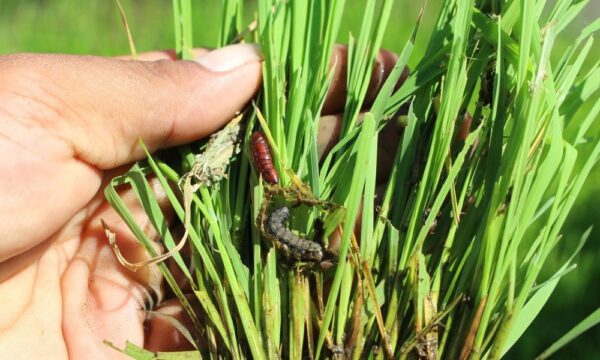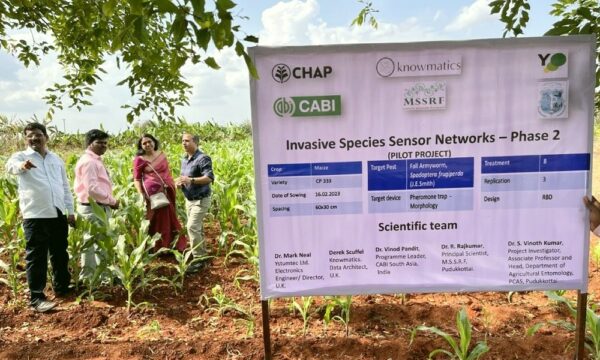
Take a quick look at the map of the fall armyworm invasion. It gives you a good feel for the number of smallholder farmers in sub-Saharan Africa directly affected by a small caterpillar eating their staple crop – maize – at a rapid rate. As a communication professional working in agriculture, it has been the first time I have found it so easy to explain my work – “ah yes, you are working on this ‘worm’… it is causing so many problems for farmers here” is the response I now get.
Looking back on the outbreak of fall armyworm (FAW) in Africa, it is now clear to see that countries were not prepared for an invasion on that scale. Aside from outbreaks such as the desert locust and the African armyworm which are limited to an extent by climatic conditions, countries haven’t seen such a major pest outbreak in recent memory. The challenge for governments and organisations to respond to the emergency whilst researching and developing solutions has been significant.
As the coordinator of the FAO Technical Working group on Communications and Knowledge Management and in my role supporting communication activities through CABI’s development communication unit, my focus has been largely on supporting extension services and farmers to identify, monitor and manage the pest using nationally agreed recommendations and advice. In other words, I am part of a cadre of communication professionals trying to reach those farmers in their village, on their farm, and in their field so they have effective, safe, practical, available, and affordable options and information on which to act.
The group represents partners from research, communication and governmental organisations. Members include AGRA, CIMMYT, ICIPE, IAPSC, FAO, Precision Agriculture, Digital Green and Farm Radio International, AATF and USAID. These organisations have played a crucial role in deploying communication approaches to contain and manage fall armyworm in Africa over the last 18 months – between them having reached millions of farmers across sub-Saharan Africa, as a part of the joint response to the fall armyworm.

In August 2018, communications professionals met in Lusaka, Zambia
Recently this group came together with government representatives from affected countries to review communication efforts so far; identifying lessons learned that can change the way we respond to this and future pest outbreaks, because climate change, trade, and tourism are ensuring this won’t be the last. The meetings, which were held in Lusaka, Zambia were a welcome opportunity to mix with other communications professionals to discuss the common challenges and develop recommendations that are being shared across the agricultural sector.
Here are the headlines…
For pest outbreaks communication should be prioritised alongside scientific research.
While much has been done to reach extension workers and farmers, participants at the meetings in Zambia felt there was still a long way to go in ensuring everyone has access to the most up-to-date, validated and appropriate information and advice. Outreach efforts haven’t yet reached all extension workers in countries and further funding is required to complete this task. This gap is leading to patchy communication with farmers, who are often left to plan for and manage the fall armyworm without expert advice. It was also noted that capacity for effective science communication to translate technical information into language understood by farmers and intermediaries at a national level was limited and that in some cases only technical materials were available for use in the field. There has been agreement that the development of a strategic communication framework for governments would be useful to facilitate the planning of resource allocation and effective design of activities for pest outbreaks going forward – this is now being taken forward by the Technical Working Group.
Farmer feedback is vital to effectively communicate and manage FAW.
There is need for consideration of how farmers access and use information, the context in which they are making farm management decisions and which local practices they are developing themselves. It was felt that priority should be given to researching the efficacy of some of the most well-used of these as part of the integrated pest management package and to including feedback mechanisms in any communications activities to understand their impact as they happen.
Institutional advocacy for preferred management options is a barrier to effective pest management.
It has been noted that some stakeholders are investing in developing solutions according to their own objectives – on for example, the use of pesticides. These differing perspectives often create barriers to partnership efforts on communication – with debate around what management methods should be recommended, for instance. This needs to be recognised and managed. At a national level the group recommends it should be the remit of the fall armyworm task force to determine which technologies and activities are the most appropriate and therefore are implemented. This task force should also take account of local realities as reflected by the voice of the farmer in rural communication approaches.
National task forces need to be strengthened.
The role of the press in influencing the response to fall armyworm in some countries has been clear, where panic generated by coverage led to very high pesticide usage, with the associated risks. Equally worrying has been the fact that mixed messages have often been given to extension workers and farmers, leading to confusion on what actions to take. To address these concerns we recommend that national task forces be strengthened and that communication experts with suitable authority should be included to support national planning and management of harmonised communication strategies. It should also be recognised that communication is not a one-off exercise and that support is required through the lifetime of a pest incursion, and as new technologies are identified and made available.
FAW provides a learning opportunity for future pest outbreaks.
Given the large number of countries affected by fall armyworm in Africa and beyond, many organisations are working on research into management solutions. This provides a huge opportunity for innovation, synergies and collaboration if coordinated well through the mechanisms which already exist. It was recommended that findings from nationally-based research should be shared with working groups on fall armyworm and made widely available so that there is an opportunity for regional learning and response as well as continent wide.

Communications work brought fall armyworm video screenings to villages in Ghana
From a personal perspective I am excited by the debate around science and development communications that this insect pest has provoked. Clearly the role of communication in agriculture is being recognised in a similar way to that which it plays in human health. My hope is that what is learned now by all parties will be benefited from in the coming years.
4 Comments
Leave a Reply
Related News & Blogs
Revolutionizing crop protection: Success of a novel approach to combatting fall armyworm in India
The global battle against invasive pests has found a new champion with pioneering efforts to combat the fall armyworm (Spodoptera frugiperda) in India. This is thanks to a sensor-based pheromone trap – that can be operated remotely anywhere in the worl…
18 August 2023





[…] Fall armyworm in Africa: communicating out of a crisis […]
[…] of a set of protocols to support government response to outbreaks and includes information on the case for communication during an outbreak, funding provisions, coordination of partners, approaches, and monitoring and evaluating […]
[…] of a set of protocols to support government response to outbreaks and includes information on the case for communication during an outbreak, funding provisions, coordination of partners, approaches, and monitoring and evaluating […]
[…] Fall armyworm in Africa: communicating out of a crisis […]